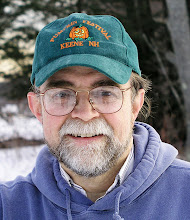It was March of 1970. I was penned up in my New Hampshire dorm
rooms when a partial solar eclipse darkened the skin over Hanover. It wasn’t the spectacular drama of a total
eclipse, but I do remember looking out of my window to see the mass of my
fellow “scholars” pounding pots and pans to encourage the weakened sun to
return. I could have travelled to see
the total eclipse – the Southeast coast of the US would have served, but, at
the time, I was barely 20 years old, and it didn’t seem that important to make
the effort.
 |
| Path of Totality April 8 2024 |
As eclipse day approached, I planned to travel to the Burlington Vermont area, but within a day or two it
looked like that region might be on the approaching edge of overcast skies. It began to make sense to move my target
northeast to the northern border of New Hampshire. Monday morning, eclipse day, Susan, Benjamin
Pierce (our wonderful Goldendoodle) and I Headed for Colebrook New Hampshire. Predictions of nightmare traffic led us to leave
at 6:30AM, but the trip north was a breeze.
We arrive in Colebrook with five hours to kill before the beginning of
the eclipse and had plenty of time to find a good place to settle in for the
show.
 |
| Eclipse Necessity |
With Susan doing the planning
we had most of what we needed, our folding chairs, sandwich fixings, lots of
terrible but delicious snacks, water, food for the dog, eclipse glasses and an
eclipse filter for my 400mm lens. As we
searched for a spot, we had only two additional criteria, an unobstructed view
of the sun and porta potties. We found
both in a parking area set aside by the nice people of Colebrook.
 |
| First Bite of the Moon |
I had plenty of time to get
my camera set up. I focused the 400mm
lens on the trees of a distant mountain ridge and then used gaffer’s tape to
fix my focus on infinity. Exactly as
predicted beginning at 2:16PM, the moon began nipping larger and larger pieces
of the sun. The process took about one
hour so I grabbed images about every five minutes. As the sky slowly darkened, it took on an eerie
grayish twilight and the temperature dropped.
 |
| Totality Lower Exposure Reveals Solar Prominences |
Suddenly, as if by flipping a
switch, totality blinked on. Despite all
my planning, panic set in. I rushed to capture
a range of exposures, but then I realized I was at risk of missing the
experience while trying to capture it. For the last half of totality, I just
settled back and enjoyed the view. It was spectacular and must be experienced
to be appreciated. I haven’t seen any
photograph that fully captures the phenomenon. In addition to the bright
corona, I was especially struck by the brilliant red of a solar prominence that
peaked around the lunar disc.
 |
| Nearly 3 Minutes of Totality |
In Colebrook the duration of totality was just
under three minutes, but it seemed like 30 seconds. Shortly after totality, we packed up and hit the road. I felt a little guilty not waiting for the full
process of the reemergence of the sun, but, like most everyone in the world, we
knew what a nightmare the traffic would be heading south. |
| First Sliver of the Sun's Return |
And it WAS a nightmare! Normally
it should take about 3 hours to make it home, but it ended up taking 8 hours
before we staggered back to Spofford NH.
 |
| Route 91 - The Crawl |
We initially found a few less congested back roads, but quickly, every
path was clogged and the main route south, on Route 91, was a languid parking
lot. We left Colebrook at 4PM and finally got home at about midnight. There were a few saving graces, including the chance to listen
to some fun music, and the blessing of a wonderfully relaxed dog. Benji
actually handled the slog with far fewer complaints than either Susan or I. (And without drugs!)
We have now recovered from
the journey, and I’ve had a chance to review my images. In just a few days, the pain has faded, and
the wonders of the experience are growing. The long journey has become just
part of the whole remarkable experience and will blend with our memories of
this amazing, once in a lifetime event. I’m
very glad that I made the effort to check this one off my list.
Jeff Newcomer
www.partridgebrookreflections.com

.jpg)




























































